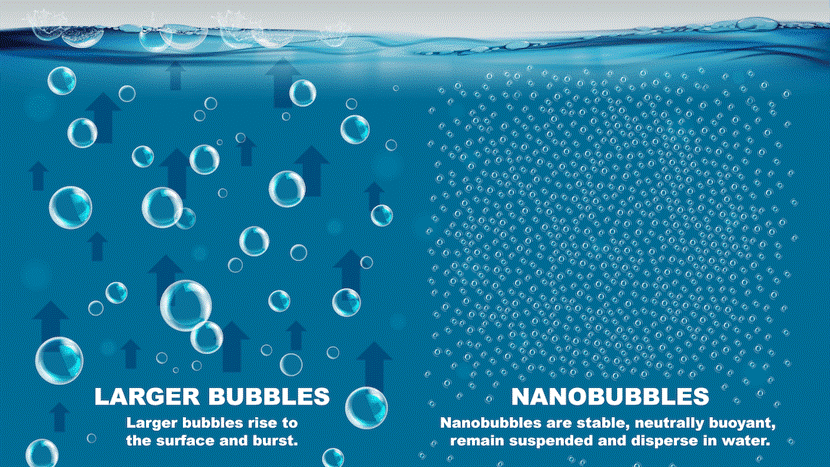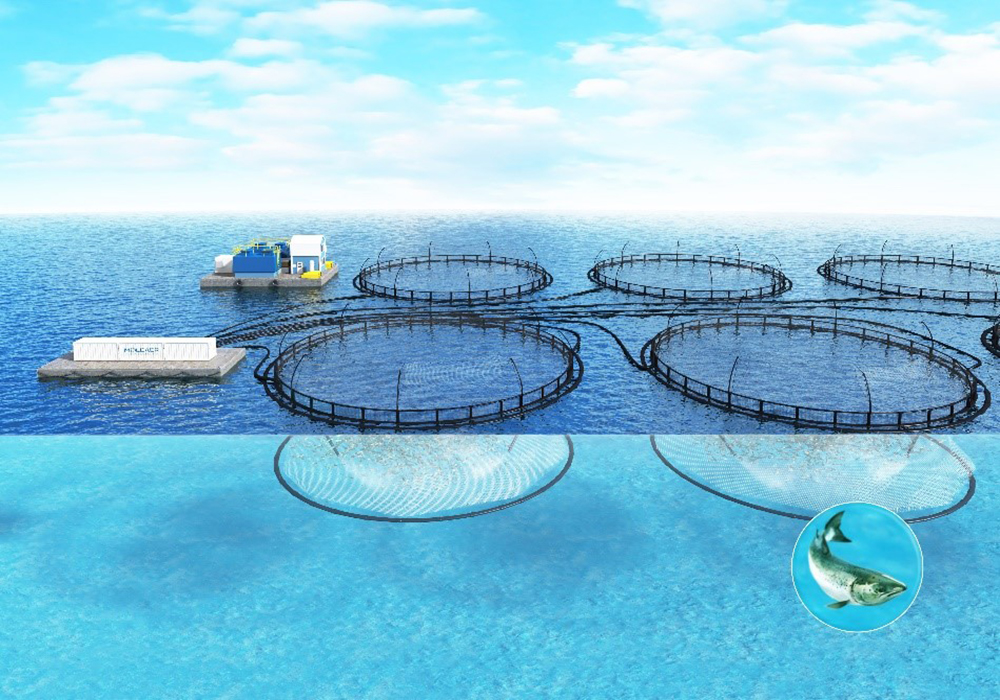There’s been a lot of buzz around GPT and AI chat lately, so we wanted to know what AI has to say about nanobubble and nanobubble technology. Here are the questions we asked Chat GPT and its answers.

What are nano bubbles?
Nanobubbles are tiny air bubbles less than 100 nanometers in diameter and are considered the smallest form of air bubbles. They are made up of a thin layer of gas, typically air or oxygen, surrounded by a liquid, such as water.
Nanobubbles are of interest because of their unique properties that set them apart from normal sized air bubbles. These include small size, high stability and the ability to remain suspended in liquid for long periods of time.
One of the key properties of nanobubbles is their ability to dissolve gasses into liquids in a much more efficient way than traditional bubble-based methods. This makes them useful in a variety of applications, including water treatment, biomedical imaging, and drug delivery.
Nanobubbles can also be used in the oil and gas industry, where they are used to enhance oil recovery from wells by reducing the viscosity of crude oil and increasing its fluidity. This makes it easier to extract oil from the well, which improves production and increases efficiency.
In the agricultural sector, nanobubbles have been shown to have a positive effect on plant growth and yield. By introducing oxygen into the soil and roots, nanobubbles can improve soil aeration, promote better root growth, and increase nutrient absorption.
Despite their potential benefits, much remains to be learned about nanobubbles and their properties. More research is needed to fully understand the potential applications of these tiny air bubbles and how they can be used to improve various industries and processes.
Overall, nanobubbles are an attractive and potentially useful form of air bubbles that are being studied and explored for their unique properties and potential applications.
What is the future of nanobubbles?
The future of nanobubble technology has a lot of potential and is expected to witness significant growth in the coming years. Here are a few areas where nanobubble technology is expected to play an important role:
- Water treatment: Nanobubbles have shown potential in improving the efficiency of water treatment processes, such as removing pollutants and improving water quality. It is possible to continue to develop and deploy nanobubble technology in this area in the future.
- Agriculture: As mentioned earlier, nanobubbles have the potential to improve crop growth and yield by introducing oxygen into the soil. This technology is expected to gain popularity and be adopted by farmers around the world in the future.
- Biomedical Applications: Nanobubbles have the potential to be used in various biomedical applications, such as drug delivery and cancer treatment. There will likely be continued research and development in this area, leading to potential new treatments and therapies.
- Energy industry: Nanobubbles have the potential to improve oil extraction from wells, which could lead to increased efficiency and improved production in the energy industry. It is likely to continue to explore the potential of nanobubbles in this area.
- Environmental applications: Nanobubbles can be used to improve the efficiency of various environmental processes, such as removing pollutants from water. It is possible to continue to develop and deploy nanobubble technology in this area in the future.
Overall, the future of nanobubble technology looks promising with many potential applications and many growth opportunities. As more is known about these tiny air bubbles and their unique properties, it is likely that they will become increasingly important in many industries and applications.
How do nanobubbles apply in agriculture
Nanobubbles are tiny air bubbles with diameters on the nanometer scale, typically 1 to 100 nanometers. They are created using a high-pressure system to inject gas into a liquid. In agriculture, nanobubbles have been shown to have a number of potential applications, including improving crop yields and reducing the use of pesticides and fertilizers.

One of the most promising applications of nanobubbles in agriculture is in hydroponic systems. Hydroponics is a method of growing plants without soil, using only water and nutrient solution. By injecting nanobubbles into water, researchers have found that plants can absorb more oxygen, which can lead to faster growth and higher yields. In addition, the air bubbles can help keep the water carbonated, which can prevent the growth of harmful bacteria and fungi.
Another potential application of nanobubbles in agriculture is to reduce the use of pesticides and fertilizers. By injecting nanobubbles into the soil, researchers have found that plants can absorb more nutrients from the soil, which could reduce the need for chemical fertilizers. Additionally, air bubbles can help create a barrier around plants, which can prevent pests from attacking them.
Nanobubbles may also have potential in agriculture as a way to improve the efficiency of irrigation systems. They can be used to create a mist or mist of water droplets that can be sprayed directly on plants, which can reduce the amount of water needed for irrigation.
Despite the potential benefits of nanobubbles in agriculture, research in this area is still in its early stages and more research is needed to fully understand the potential applications and limitations of this technology.
How do nanobubbles improve aquaculture
Nanobubbles have the potential to improve aquaculture by increasing oxygen levels in the water, which could have several benefits for aquatic organisms. Here’s how they do it:
Increase oxygen level: Nano bubbles bring oxygen into the water, which can improve oxygen levels and help maintain a healthy water environment. This is important for the growth and survival of aquatic organisms, including fish, shellfish, and crustaceans.
Improve water quality: The introduction of oxygen into water can also help improve water quality by reducing the accumulation of harmful chemicals, such as nitrogen and phosphorus. This can lead to a healthier aquatic environment, improving the growth and survival rates of aquatic organisms.
Increase feed conversion efficiency: Nanobubbles can also increase feed conversion efficiency, which is the process by which aquatic organisms convert food into growth and energy. By improving the oxygen concentration in the water, nanobubbles can help increase the efficiency of feed conversion, leading to improved growth rates and survival rates of aquatic organisms.
Reduce stress and improve health: Nano air bubbles can also help reduce stress and improve the health of aquatic creatures. This is because increased oxygen levels can help reduce the build-up of harmful chemicals, such as carbon dioxide, and improve overall water quality.

Overall, nanobubbles have the potential to improve aquaculture by increasing oxygen levels in the water, improving water quality, which can lead to improved growth and survival of aquatic organisms. water. There is likely to be continued research and development in this area, leading to further advancements and benefits for the aquaculture industry.
Sharing about nano bubbles in ponds and lakes
Nanobubbles can also be used in ponds to improve water quality and support the growth of aquatic life. Here’s how they function:
- Increase oxygen level: Nano bubbles bring oxygen into the water, which can improve oxygen levels and help maintain a healthy water environment. This is important for the growth and survival of aquatic organisms, including fish, algae, and plants.
- Improve water quality: The introduction of oxygen into water can also help improve water quality by reducing the build-up of harmful chemicals, such as nitrogen and phosphorus. This can lead to a healthier aquatic environment, improving the growth and survival rates of aquatic organisms.
- Algae control: Nanobubbles can also help control harmful algae growth in lakes and ponds. This is because increased oxygen levels can help reduce nutrient buildup that can lead to harmful algal blooms.
- Aquatic Plant Growth: Nanobubbles can also support the growth of aquatic plants, which play an important role in maintaining a healthy aquatic environment by providing oxygen and habitat for life. aquatic.
Overall, nanobubbles can play a role in improving water quality and supporting the growth of aquatic life in ponds and lakes. There is likely to be continued research and development in this area, leading to further advances and benefits for the conservation management of these important ecosystems.
See also: How does water softeners help prevent itching after shower
Follow Fanpage: https://www.facebook.com/SongPhungthietbinganhnuoc/ to update new products
Translator: Duong Nguyen Hoang Khang

